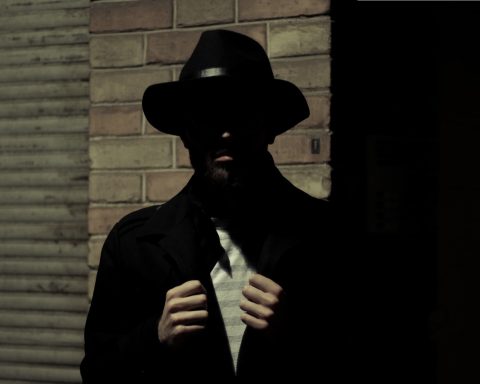Natasha Houghton is an RACP physician in training and a simulation fellow at ICL. She investigates how simulation-based innovations and collaboration with experts outside the world of healthcare can contribute to medical education.
Roger Kneebone is Professor of Surgical Education at Imperial College London (ICL) and co-director of the Centre for Engagement and Simulation Science. He was a trauma surgeon, then a general practitioner before specialising in simulation and surgical education. Roger also directs the Royal College of Music (RCM) – Imperial College Centre for Performance Science, which explores challenges of performance across domains, from the arts, education and business to medicine, science and sport.
Will Houstoun is an international award-winning magician and instructor, with a PhD in the history of magic education. He specialises in consultancy for media and advertising as well as instruction on both the technical and historic aspects of magic.
Neighbour’s book says little about the specifics of disease or diagnosis. Instead it describes the consultation as a journey, punctuated by checkpoints: connecting, summarising, handing over, safety-netting and housekeeping, to use his terminology. Written in a conversational style, The Inner Consultation draws on philosophy, sport and psychology as well as the work of pioneers in general practice.1 It is more than thirty years since The Inner Consultation was first published. This seminal book by GP Roger Neighbour explores how the consultation itself can be mapped. When it was published, one of the authors of this paper (RLK) was a GP trainee, making the transition from surgery to general practice. This book’s impact on him was profound. Neighbour framed the consultation not only as a vehicle for applying biomedical knowledge or exercising procedural skill, but as a complex interaction with its own dynamics. One of his insights was to acknowledge the internal state of the doctor during each consultation, exploring how this can affect the outcome.
The internal state of the doctor during each consultation … can affect the outcome.
In June 2020, RLK met Neighbour for the first time, albeit online because of the Covid-19 pandemic. In an extended conversation for RLK’s podcast Countercurrent, Neighbour described how he came to write the book, outlining the experiences (as a Zen practitioner, a musician and a tennis player, as well as a doctor) which helped to shape it.2 He explained how he drew on aspects of himself that lay beyond memorising lists of diseases or biochemical pathways, and how he codified the process of engaging with patients to identify and address their concerns.
The consultation as a close-up live performance
Framing the clinical consultation as performance lies at the heart of Neighbour’s thinking. Though for some clinicians the term ‘performance’ has a disquieting whiff of showmanship, we believe that authentic performance in medicine is not contrived. On the contrary, it is how the relationship of care is expressed.3 Its aim is to shape and respond to what emerges between a clinician and a patient as they interact, reaching a point where all agree that progress has been made. This is a demanding process.
Authentic performance in medicine is not contrived …. it is how the relationship of care is expressed.
Stepping aside from content knowledge allowed Neighbour to address aspects of the consultation which had often been overlooked. We have taken this a stage further by viewing the consultation through analogy with an apparently unrelated domain – magic. Two of us (RLK and NH) are clinicians at different stages of our careers, while the third (WH) is an award-winning close-up magician with a PhD in the history of Victorian magic. This collaboration has allowed us to examine ‘close-up live performance with a very small audience’. This is something all three of us are familiar with, whether in the consulting room or at an intimate magic show for an audience of just a couple of people.
Neighbour’s stages have striking parallels within close-up magic. Of course, we do not suggest that clinical consultations should be considered in terms of entertainment. Yet though the purposes and content of medical and magical performance are poles apart, their processes show surprising similarities. Magic can only occur through collaboration between magician and audience. In typical settings, such as a restaurant or club, a magician must quickly capture the attention of the audience and put them at ease, establishing a receptive frame of mind and allaying any concerns that they might be embarrassed or made to feel stupid. Within the tricks themselves, there are aspects the audience must register in order to experience the seemingly impossible. Other details would disclose the trick’s method and must therefore be concealed. An expert magician highlights certain points while keeping others out of focus, ensuring the audience is left with a satisfying experience. The performer must leave space for the audience to respond. This provides a story to take away from their experience, when they recall what happened and when they relay it to others. And after the show is over, a magician must make sure they are ready for the next performance, with any props back in the correct place and the best frame of mind to carry on. This is especially challenging if things have gone awry. All these features have parallels in the clinical world. For example, the magician’s need to plan for the unexpected resonates with Neighbour’s ‘safety-netting’, a principle that underpins the whole performance. As in medicine, an expert magician will have contingency plans for predictable mishaps, as well as remaining alert for the unexpected.
Medical and magical performance … processes show surprising similarities.
How does this relate to current clinical practice? NH is a physician trainee who, five years after graduating, has absorbed most of the medical knowledge needed to deliver high quality care. Yet she is aware that medical knowledge alone cannot guarantee a satisfactory outcome. That requires the ability to navigate complex dynamic interactions. Dialogue with performers outside medicine invites trainees to develop expertise in this often-overlooked area. For example, a performance approach to safety-netting – that dynamic process of contingency planning and constant monitoring which starts before a performance and continues after – could prepare trainees to tackle unexpected clinical circumstances with confidence and respond effectively to complications. Such skills become increasingly important as clinicians move towards independent practice as consultants or GPs.
Clinicians are increasingly conscious of the need to acknowledge their internal states and recognise its impact on patients and themselves. Most trainees are aware that negative internal states can impair the care they provide. Yet awareness on its own is not sufficient. Clinicians must know how to ‘re-set’ their approach and bracket out unhelpful concerns when they are with patients. Magicians understand this too. WH chooses to take on stage with him only those aspects of his internal state that will benefit his performance. He recognizes negative aspects and temporarily leaves them behind. This approach acknowledges that all aspects of a performer’s internal state (positive and negative) are genuine and must be addressed at a suitable time. But during a performance or consultation, amplifying aspects that are useful (such as curiosity, empathy and care) and excluding those that are not (such as irritation, anger and stress) will make a successful outcome more likely. By acknowledging negative internal states – suspending rather than suppressing them, and returning to address them later – clinicians can take better care of themselves and their patients.
In recent years we have explored performance parallels through studies with clinicians at various career stages. Participants include post-graduate surgical trainees (Imperial MEd in Surgical Education), undergraduate medical students (Imperial MBBS first year), and secondary school students aspiring to become doctors (Wellcome Trust Saturday Studio). After practising and performing a simple piece of magic, ‘sense-making’ conversations explored how principles of magic performance could be used in clinical practice. These events proved richly informative, resonating at multiple levels of experience. Undergraduate students focused on specific techniques (such as the use of eye contact to capture and shape a patient’s attention through non-verbal communication), while postgraduate trainees focused more on metacognitive strategies (exploring approaches to authentic engagement which accounted for clinicians’ internal states).
Undergraduate students focused on specific techniques …. while postgraduate trainees focused more on metacognitive strategies.
Current implications
The Covid-19 pandemic has-brought about profound changes in clinical consultations, especially in UK general practice. Some of these changes are probably irrevocable. Remote and online consultation are becoming the norm. Yet the essence of the consultation remains unaltered. Each encounter needs to go to the heart of a person’s problem, pinpointing key issues and coming up with a workable solution or approach. At the same time, clinicians must continue to be aware of their internal state and pay attention to their mental health.4-6 To encompass all this in a post-Covid-19 world requires us to reframe the consultation, retaining what is essential and changing what must be changed. This is a timely opportunity to revisit the consultation and learn from experts outside medicine. For magicians too are re-imagining their practice.
WH continues to perform and teach, though no longer in person. He is exploring how remote encounters can inspire new approaches to performance and tuition.7 Online magic, for example, can capture the best of live television – retaining the excitement and interaction that comes from in-person delivery – while exploiting technology’s potential to address individuals directly. Online platforms remove geographical constraints, allowing live performance to be delivered to hundreds or even thousands of ‘single-person audiences’, rather than a single group in a theatre. Such technologies allow magicians to use material that would previously have been too small to see or impossible to travel with.
Online platforms offer similar opportunities in the clinical world. Circumventing geographical constraints improves access for rural populations, allows centralisation of care for patients with rare conditions, and increases training opportunities for doctors through exposure to important but low prevalence presentations.8 Yet though the benefits of remote practice have long been recognised, its potential has been under-explored. Such opportunities have been slow to take hold in the UK. The explosive increase in remote care triggered by Covid-19 offers opportunities to re-imagine the consultation in an online environment, taking advantage of new possibilities which technology offers rather than ‘making the best of a bad job’.
The consultation must continue to underpin our relationship of care with our patients.
To do this we need to ensure that key components of each consultation – connecting, summarising, handing over, safety-netting and housekeeping (to return to Neighbour’s framework), will persist. The consultation must continue to underpin our relationship of care with our patients. By collaborating with experts outside medicine, those aspects of medical practice that go beyond biomedical knowledge come into sharper focus. Human encounters – whether in medicine, magic or anything else – benefit from insights outside one’s immediate field. Thirty years after The Inner Consultation, perhaps it is time to think again about the 21st century consultation, and how we can ensure that the magic of medicine remains at its core.
References
1. Neighbour R. The inner consultation. MTP, 1987.
2. Kneebone RL. Roger Neighbour in conversation with Roger Kneebone. Countercurrent. 2020 Available at: https://rogerkneebone.libsyn.com/roger-neighbour-in-conversation-with-roger-kneebone. Accessed November 24, 2020.
3. Kneebone R. Dissecting the consultation. The Lancet. 2019;393(10183):1795.
4. Gerada C. Clare Gerada: Dissecting resilience. BMJ. 2018 Nov 28;363:k4974.
5. Gerada C. Clare Gerada: Doctors and their defences. BMJ. 2019:l871.
6. Gerada C. Clare Gerada: Mindfulness is useful but not the only option. BMJ. 2019:l5698.
7. Houstoun W, Thompson S. Video Chat Magic. Genii: Thee Conjurors’ Magazine.2020 Aug 83(8);42-45.
8. Eze ND, Mateus C, Cravo Oliveira Hashiguchi T. Telemedicine in the OECD: An umbrella review of clinical and cost-effectiveness, patient experience and implementation. PLoS One. 2020 Aug 13;15(8):e0237585.
Featured photo by Almos Bechtold on Unsplash






